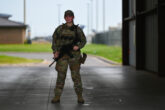September 27, 2024
The Melting Fortress: The United States, Canada, and the Race Against Time in the Arctic
For years, Moscow has prioritized the Arctic as a critical pillar of its national security, opening or refurbishing over 50 military bases and scaling up military operations across the region. The United States, meanwhile, with a focus alternating between the Middle East and the Pacific, has largely entrusted Arctic security to its allies and partners in the region.
The problem: One of those key partners, Canada, is by its own admission unprepared to face the Arctic challenge. Unless the US works quickly to help fill that gap, it means American interests in the Arctic are going to be at risk moving forward.
Historically, the United States has been protected by the operational challenges of waging an Arctic offensive in frigid conditions. But the growing prospect of a “Blue Arctic,” ice-free for months out of the year, could allow a great power adversary to deploy military assets right in America’s backyard for the first time in history. Already, Russian and Chinese warships have been seen patrolling together off the coast of Alaska in unprecedented numbers. As the US military’s former top commander for the Arctic, Gen. Terrence J. O’Shaughnessy said, the region is “no longer a fortress wall” and we must be prepared to defend it.
Right now, Canada cannot be the bulwark of Arctic security and certainly cannot be the linchpin of the US Arctic strategy.
In the Arctic, Russia is not a “pacing threat” as China is in the Indo-Pacific; it is well ahead of the United States. Russia controls nearly 53 percent of the Arctic Ocean’s coastline and has built countless bases across the region. Washington, meanwhile, only maintains six bases and five of them are outside of the Arctic Circle in southern Alaska. As of 2023, the United States Coast Guard possessed only five icebreakers or ice-capable patrol ships which are critical to maintaining a presence in the Arctic. Moscow, meanwhile, has 57 such vessels. It will be years before the American icebreaking fleet is large enough to effectively support large-scale US operations.
In addition to rapidly scaling up its force posture, Russia has also conducted unprecedented naval exercises and harassed American fishing vessels in Arctic waters. Moscow has begun to assert its control over newly expanded shipping lanes through the Arctic like the Northern Sea Route (NSR), declaring certain parts of this route to be internal Russian waters with an aim towards regulating shipping that passes through it.
In the future, Russia may try to expand its control over other Arctic waters closer to the United States and present a direct threat to the homeland and to US operations in Europe and the Indo-Pacific. The United States Navy’s top Arctic commander, Adm. Daryl Caudle fears that Moscow may try to create its own “‘nine-dashed line’ around the North Pole.”
Read the full article from Breaking Defense.
More from CNAS
-
National Security Human Capital Program
Short SupplyExecutive Summary The U.S. military faces a critical challenge: Fewer young Americans are willing to serve, and fewer adults are encouraging them to do so. Because of delibera...
By Katherine L. Kuzminski & Taren Sylvester
-
National Security Human Capital Program
Defending the Army’s Command Assessment ProgramThe concept for CAP — developed during the first Trump administration — benefited from the guidance, input and oversight from the foremost scholar and practitioner on military...
By Katherine L. Kuzminski
-
National Security Human Capital Program
‘Women Don’t Just Achieve…They Excel’: Fmr. Marine Corps Attack PilotDr. Kyleanne Hunter, former Marine Corps attack pilot and CEO of Iraq & Afghanistan Veterans of America, says “women are the fastest growing group of veterans” and “the fastes...
By Dr. Kyleanne Hunter
-
National Security Human Capital Program
A Workforce Strategy for America’s Shipbuilding FutureThe future of American maritime dominance will not be determined solely by the number of ships launched or contracts signed, but rather by the strength and sustainability of t...
By Katherine L. Kuzminski & Laura Schmiegel




